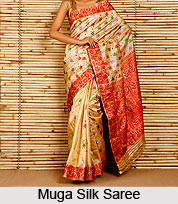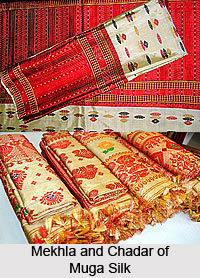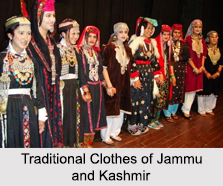 Muga sarees are the famous silk sarees produced only in Assam. Muga sarees are not only elegant and beautiful but they also have ample strength and durability. Ladies of all ages wear the Muga sarees on festive and auspicious occasions. Muga silk sarees are the exclusive creations of the artisans of east India. These sarees are admired for the natural sheen and gorgeousness they possess. The word "Muga" means yellowish in Assamese. The Muga silk saree is known for its unparalleled golden hue. The saree is made from this fine fabric and is also traditional to Assam`s heritage and culture. The Muga silk is a produce of the silkworm and only in Assam, which makes this saree one of the finest rarest and extremely costly. Muga Silk is supposed to be one of the costliest fabrics in the whole world.
Muga sarees are the famous silk sarees produced only in Assam. Muga sarees are not only elegant and beautiful but they also have ample strength and durability. Ladies of all ages wear the Muga sarees on festive and auspicious occasions. Muga silk sarees are the exclusive creations of the artisans of east India. These sarees are admired for the natural sheen and gorgeousness they possess. The word "Muga" means yellowish in Assamese. The Muga silk saree is known for its unparalleled golden hue. The saree is made from this fine fabric and is also traditional to Assam`s heritage and culture. The Muga silk is a produce of the silkworm and only in Assam, which makes this saree one of the finest rarest and extremely costly. Muga Silk is supposed to be one of the costliest fabrics in the whole world.
The sheen of this fabric is said to increase more with every wash and believed to last for generations. The Muga silk filament cannot be bleached and hence cannot be dyed. There is a natural golden and shimmering look in Muga silk which cannot be found in other silk varieties. On 23rd August 2007 Assam"s Muga silk has been added to the list of products granted the protection of geographical indication (GI).
Muga Silk
The golden silk known as "Muga Silk" is not only a unique silk product from Assam, but also a symbol of rich Assamese culture and part of traditional attire of the region. It is a pride of Assam. Muga silk is the product of the silkworm Antheraea assamensis endemic to Assam. This is a wild caterpillar reared in Assam, India. These silkworms feed on the aromatic leaves of Som and Soalu plants and are reared on trees similar to that of Tussar. The silk produced is golden in colour. The silk produced is known for its glossy fine texture and durability.
History of Muga Silk
 Muga is a special type of wild silk. Muga silk was unknown to outside world until 1662, till French Explorer Mr. Jean Joseph Taverniere discovered Muga Silk during an exploration to Assam region of India.
Muga is a special type of wild silk. Muga silk was unknown to outside world until 1662, till French Explorer Mr. Jean Joseph Taverniere discovered Muga Silk during an exploration to Assam region of India.
Colour of Muga Silk Saree
Muga sarees are woven in Muga silk, which is available only in Assam throughout the world. The pride of India, Muga silk is known for its natural shimmering golden colour. The most expensive of silks, Muga is an integral part of the tradition and culture of Assam. This fabric is one of the world treasures of fine silk fabrics. The motifs and designs woven on the body have the traditional colours like red, green and black which provide a dramatic effect against the golden colour of the Muga fabric.
Designs and Motifs of Muga Silk Saree
Various motifs, butis are knitted or woven on the saree and its border. The motifs used in these sarees are mostly traditional symbols of animals, human figures, creepers, flowers, birds, channels, cross borders, the galaxy and ornamental designs. Wedding Mekhla Chaddars are adorned with gold and silver thread work.
Production of Muga Silk
An interesting equation to note is that it takes about 1000 cocoons to generate 125 grams of Silk and around 1000 grams of Silk is needed for a saree. Over and above, the time taken to make one single saree is about two months right from rearing the silkworm to the finished product. The weaving process of the Muga silk saree alone takes up one week to ten days to complete.
Speciality of Muga Silk Saree
Here comes the handloom each one is so unique created by hand and the design can not be exactly same because of hand weave is just like a painting which is so beautiful to look at, it is pure, it is different and it is definite and not common. Most of the sarees are one piece not copied several time. The excellent humidity absorption quality of Muga makes it a cool wear in summer and it is also comfortable in winter.





















